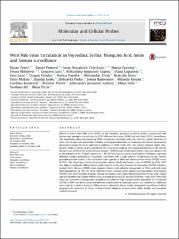West Nile virus ‘circulation’ in Vojvodina, Serbia: Mosquito, bird, horse and human surveillance
| dc.contributor.author | Petrić, Dušan | |
| dc.contributor.author | Petrović, Tamaš | |
| dc.contributor.author | Hrnjaković Cvjetković, Ivana | |
| dc.contributor.author | Zgomba, Marija | |
| dc.contributor.author | Milošević, Vesna | |
| dc.contributor.author | Lazić, Gospava | |
| dc.contributor.author | Ignjatović-Ćupina, Aleksandra | |
| dc.contributor.author | Lupulović, Diana | |
| dc.contributor.author | Lazić, Sava | |
| dc.contributor.author | Dondur, Dragan | |
| dc.contributor.author | Vaselek, Slavica | |
| dc.contributor.author | Živulj, Aleksandar | |
| dc.contributor.author | Kisin, Bratislav | |
| dc.contributor.author | Molnar, Tibor | |
| dc.contributor.author | Janku, Djordje | |
| dc.contributor.author | Pudar, Dubravka | |
| dc.contributor.author | Radovanov, Jelena | |
| dc.contributor.author | Kavran, Mihaela | |
| dc.contributor.author | Kovačević, Gordana | |
| dc.contributor.author | Plavšić, Budimir | |
| dc.contributor.author | Jovanović Galović, Aleksandra | |
| dc.contributor.author | Vidić, Milan | |
| dc.contributor.author | Ilić, Svetlana | |
| dc.contributor.author | Petrić, Mina | |
| dc.date.accessioned | 2021-02-12T09:13:32Z | |
| dc.date.available | 2021-02-12T09:13:32Z | |
| dc.date.issued | 2017 | |
| dc.identifier.issn | 0890-8508 | |
| dc.identifier.uri | https://repo.niv.ns.ac.rs/xmlui/handle/123456789/341 | |
| dc.description.abstract | Efforts to detect West Nile virus (WNV) in the Vojvodina province, northern Serbia, commenced with human and mosquito surveillance in 2005, followed by horse (2009) and wild bird (2012) surveillance. The knowledge obtained regarding WNV circulation, combined with the need for timely detection of virus activity and risk assessment resulted in the implementation of a national surveillance programme integrating mosquito, horse and bird surveillance in 2014. From 2013, the system showed highly satisfactory results in terms of area specificity (the capacity to indicate the spatial distribution of the risk for human cases of West Nile neuroinvasive disease - WNND) and sensitivity to detect virus circulation even at the enzootic level. A small number (n ¼ 50) of Culex pipiens (pipiens and molestus biotypes, and their hybrids) females analysed per trap/night, combined with a high number of specimens in the sample, provided variable results in the early detection capacity at different administrative levels (NUTS2 versus NUTS3). The clustering of infected mosquitoes, horses, birds and human cases of WNND in 2014e2015 was highly significant, following the south-west to north-east direction in Vojvodina (NUTS2 administrative level). Human WNND cases grouped closest with infected mosquitoes in 2014, and with wild birds/mosquitoes in 2015. In 2014, sentinel horses showed better spatial correspondence with human WNND cases than sentinel chickens. Strong correlations were observed between the vector index values and the incidence of human WNND cases recorded at the NUTS2 and NUTS3 levels. From 2010,West Nile virus was detected in mosquitoes sampled at 43 different trap stations across Vojvodina. At 14 stations (32.56%), WNV was detected in two different (consecutive or alternate) years, at 2 stations in 3 different years, and in 1 station during 5 different years. Based on these results, integrated surveillance will be progressively improved to allow evidence-based adoption of preventive public health and mosquito control measures. | en_US |
| dc.description.sponsorship | Projects III43007 and TR31084 funded by the Ministry of Education, Science and Technological Development of the Republic of Serbia. | en_US |
| dc.language.iso | en | en_US |
| dc.source | Molecular and Cellular Probes | en |
| dc.subject | West Nile virus | en_US |
| dc.subject | Culex pipiens | en_US |
| dc.subject | Mosquito surveillance | en_US |
| dc.subject | Horse surveillance | en_US |
| dc.subject | Bird surveillance | en_US |
| dc.subject | Human surveillance | en_US |
| dc.title | West Nile virus ‘circulation’ in Vojvodina, Serbia: Mosquito, bird, horse and human surveillance | en_US |
| dc.type | Article | en_US |
| dc.identifier.doi | 10.1016/j.mcp.2016.10.01 |
Files in this item
This item appears in the following Collection(s)
-
Naučni radovi
Radovi objavljeni u naučnim časopisima

